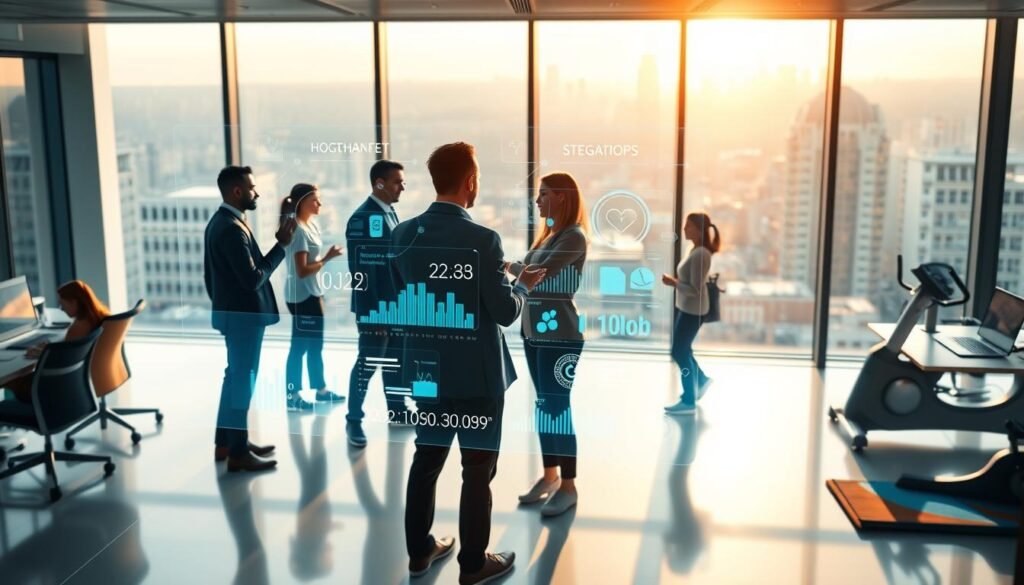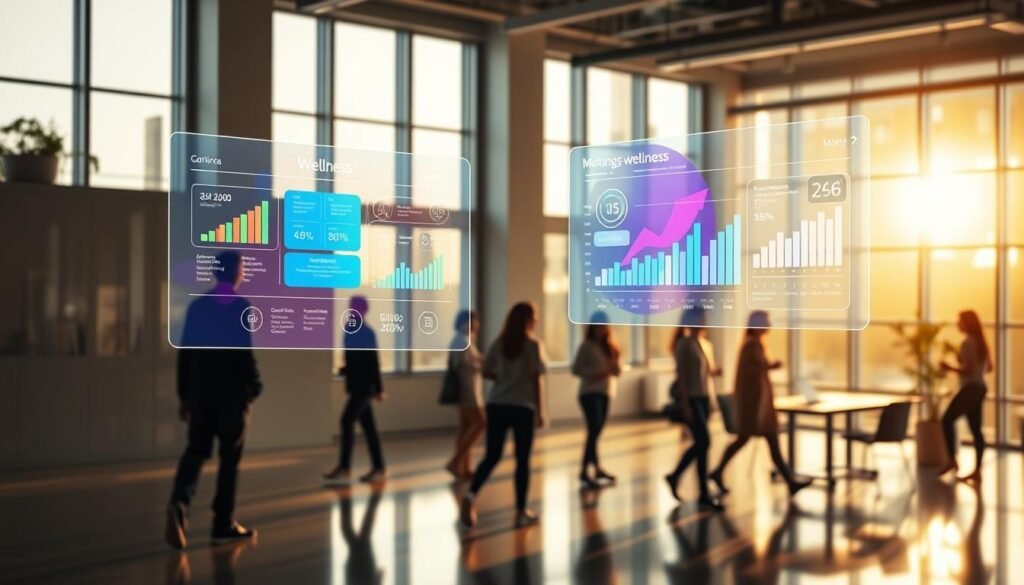Corporate Wellness AI: Revolutionize Employee Health
Modern workplaces are reimagining how they support staff well-being. Traditional health initiatives often used broad strategies that didn’t address individual needs. Now, advanced tools analyze personal data to create tailored plans for physical, mental, and financial health.
These systems do more than suggest workouts or meditation apps. They predict trends, identify risks early, and adapt recommendations in real time. For example, someone managing stress might receive customized resources, while another with sleep issues gets targeted solutions.
Businesses using these platforms report measurable improvements. Teams become more engaged, absenteeism drops, and healthcare expenses shrink. The shift from generic programs to dynamic solutions helps organizations stand out in competitive talent markets.
Key Takeaways
- Personalized health plans replace outdated one-size-fits-all approaches
- Real-time data analysis helps prevent burnout and chronic conditions
- Integrated platforms address mental, physical, and financial well-being
- Custom solutions increase engagement and program effectiveness
- Smart systems reduce operational costs while improving workforce retention
Introduction to Corporate Wellness AI
Business leaders now have smarter tools to support their teams’ holistic needs. Intelligent systems combine machine learning and real-time analytics to build tailored health strategies. These solutions adapt to individual lifestyles while covering six core areas: physical fitness, emotional balance, nutrition, work satisfaction, financial stability, and social connections.

What Makes Modern Health Solutions Effective?
Traditional workplace initiatives often offered generic advice like gym discounts or yearly check-ups. New systems analyze sleep patterns, stress markers, and activity levels through wearable devices. This data-driven approach creates plans that evolve with each person’s changing needs.
From Basic Benefits to Smart Support
Early health programs struggled with low participation—only 24% of staff used them regularly. Today’s platforms integrate with existing tools like calendars and fitness trackers. They suggest meal plans during busy weeks or adjust workloads before burnout occurs.
Over three-quarters of U.S. companies now explore intelligent tools for team support. This shift reflects a broader trend: personalized care isn’t just nice to have—it’s what keeps teams thriving.
Benefits of AI-Driven Wellness Programs
Forward-thinking companies are leveraging data to unlock new levels of team performance and satisfaction. These systems turn health metrics into actionable insights, creating workplaces where people thrive physically and mentally. Let’s explore how smart tools deliver results that generic programs can’t match.

Enhanced Productivity and Reduced Absenteeism
Health-focused initiatives now show clear returns. A recent study found programs addressing work-life balance cut absenteeism by 25% while boosting output by nearly one-third. One tech firm saw sick days drop 25% after introducing activity trackers that suggest personalized fitness goals.
Stress detection tools make even bigger impacts. When a financial services company monitored heart rate variability patterns, they identified burnout risks early. Targeted interventions like adjusted deadlines reduced burnout rates by 30% in six months.
Boosting Engagement and Satisfaction
Personalization drives participation. Platforms analyzing sleep quality, nutrition habits, and job satisfaction scores create plans employees actually use. One retailer reported 40% higher program engagement after switching to tailored recommendations.
| Metric | Traditional Programs | AI-Driven Solutions |
|---|---|---|
| Productivity Increase | 12% | 32% |
| Sick Day Reduction | 8% | 25% |
| Burnout Prevention | Limited tracking | 30% improvement |
Round-the-clock support matters too. Instant feedback through chatbots and adaptive coaching keeps teams motivated. Employees feel heard when their needs shape program updates in real time.
Real-Time Health Monitoring & Data Analysis
Cutting-edge technology now provides instant visibility into employee health metrics. Advanced systems analyze vital signs through everyday devices, transforming how organizations support physical well-being.

Tracking Key Health Markers: Heart Rate, HRV, BMI, and More
Modern solutions measure 30+ essential indicators through smartphone cameras. Remote photoplethysmography (rPPG) technology captures heart rate data with clinical-grade accuracy—errors under 0.5 beats per minute. Employees get BMI readings in 5 seconds and full health reports within half a minute.
This camera-based approach eliminates bulky equipment. “The ability to track blood pressure and stress levels during video calls changes workplace health management,” notes a recent tech study. Teams spot trends like irregular heart rhythms before they escalate.
Integrating Wearable Tech for Instant Insights
Smartwatches and fitness trackers feed data into centralized platforms. The system flags unusual patterns—like sustained high heart rates—and suggests personalized adjustments. See how traditional methods compare:
| Feature | Manual Checks | Smart Monitoring |
|---|---|---|
| Accuracy | ±3 bpm | ±0.5 bpm |
| Results Speed | 2-5 minutes | 5-30 seconds |
| Markers Tracked | 6-8 | 30+ |
| Hardware Needed | Specialized devices | Smartphone/Wearable |
Real-time alerts help employees make smarter choices. A notification about rising stress levels might trigger a breathing exercise suggestion. Managers use aggregated data to improve break schedules and workload distribution.
AI for Personalized Employee Wellness
Personalized health strategies are transforming how organizations support their teams. Advanced tools now craft unique roadmaps for nutrition and exercise, moving beyond cookie-cutter advice. This approach helps workers build sustainable habits through tailored guidance.

Custom Fitness Plans and Diet Analysis
Employees snap meal photos to get instant nutritional feedback. The system spots patterns like excess sodium or vitamin gaps. One worker discovered they ate 40% less protein than recommended through this method.
These tools adapt meal plans for allergies or preferences. A vegan employee with iron deficiency might receive spinach-heavy recipes. Someone avoiding gluten gets alternative carb sources in their weekly menu.
| Feature | Generic Plans | AI-Driven Plans |
|---|---|---|
| Participation Rate | 18% | 63% |
| Meal Plan Accuracy | 72% | 94% |
| Workout Effectiveness | Basic routines | Adaptive sessions |
| Feedback Speed | 24-48 hours | Real-time |
Fitness programs evolve with progress. A parent returning from leave might start with 10-minute home workouts. As endurance improves, the system suggests longer routines. One warehouse worker reduced back pain through tailored strength exercises.
Real-time adjustments keep challenges achievable. When someone completes three cycling sessions weekly, the app adds interval training. This dynamic approach helps 78% of users stick with their goals longer than traditional programs.
Enhancing Mental and Emotional Health with AI
Mental health challenges affect 1 in 3 workers, yet many hesitate to seek help. New tools are changing this dynamic by providing discreet, round-the-clock support through smart platforms. These solutions offer confidential conversations and personalized coping strategies when teams need them most.
24/7 Support Through Smart Coaching
Employees increasingly prefer digital assistance for sensitive issues. 68% would discuss stress with a chatbot rather than their manager, while 80% welcome tech-driven therapy options. These platforms analyze word choices during chats to suggest tailored resources like breathing exercises or mood-boosting activities.
Research shows users of these tools experience 64% greater reduction in depression symptoms compared to traditional methods. One financial firm saw email tone analysis trigger guided meditation suggestions during high-pressure periods, reducing team anxiety by 42%.
Proactive Crisis Prevention
Advanced systems detect subtle warning signs through typing speed changes or calendar patterns. Real-time alerts connect users with counselors when urgent needs arise. See how modern solutions outperform older approaches:
| Feature | Traditional Support | Smart Detection |
|---|---|---|
| Suicide Prediction Accuracy | 65% (1 week) | 92% (1 week) |
| Response Time | 24-72 hours | Under 5 minutes |
| Availability | Business hours | 24/7 monitoring |
| Confidentiality | Limited | Full anonymity |
These tools adapt to individual preferences. A parent juggling deadlines might receive quick mindfulness exercises, while a remote worker gets social connection prompts. Immediate interventions help teams build resilience during tough moments.
Improving Financial and Occupational Wellness
Financial stability forms the foundation of employee performance. With 64% of U.S. adults naming money as their top stressor, smart tools now tackle this challenge head-on. These solutions help teams manage budgets while balancing work demands effectively.
Strategic Financial Goal Planning
Modern platforms analyze income streams and spending habits to create actionable roadmaps. One user reduced credit card debt by 42% in six months using customized repayment strategies. The system adjusts recommendations when life changes occur, like a new family member or job transition.
Budgeting tools go beyond basic expense tracking. They factor in student loans, retirement targets, and emergency funds. Real-time alerts notify users about overspending risks while suggesting affordable alternatives. This approach helps 73% of participants stick to financial plans longer than traditional methods.
Smart Scheduling for Sustainable Work
Burnout prevention starts with intelligent time management. Systems track project timelines and communication patterns to spot overload risks. When workload spikes, they might propose deadline extensions or task redistribution.
| Feature | Manual Scheduling | AI Optimization |
|---|---|---|
| Overtime Reduction | 12% | 38% |
| Schedule Conflicts | 22% | 6% |
| Employee Preference Match | 54% | 89% |
Flexible arrangements prove crucial for retention. Nearly half of workers value adaptable hours more than salary increases. One logistics company reduced turnover by 29% after implementing shift-swap features and workload balancing tools.
These innovations create workplaces where financial confidence meets manageable work rhythms. Employees gain control over both wallets and calendars, leading to sharper focus during work hours.
Ethical Considerations in Corporate wellness AI
Building trust in workplace health initiatives requires more than good intentions. As wellness platforms handle sensitive details, organizations must balance innovation with responsibility. Two critical areas demand attention: protecting personal details and ensuring fair outcomes.
Safeguarding Privacy and Ensuring Data Security
Employees share health information expecting ironclad protection. Strong encryption and strict access controls prevent unauthorized use of medical histories or fitness records. Regular audits and HIPAA-compliant storage show teams their data stays confidential.
Training matters too. Staff managing these systems need clear guidelines on handling sensitive details. When workers understand how their information gets used—and protected—they’re more likely to engage fully.
Addressing Algorithm Bias and Avoiding Overreliance
Systems learn from what they’re fed. If training data lacks diversity, suggestions might favor certain age groups or ethnicities. One platform initially recommended jogging to users in walkable neighborhoods, overlooking wheelchair users’ needs until developers expanded their datasets.
Human oversight keeps recommendations grounded. While algorithms spot sleep pattern trends, managers should interpret results alongside individual circumstances. The best solutions combine smart analysis with human empathy to create truly supportive environments.
FAQ
How does real-time health tracking improve workplace productivity?
By monitoring markers like heart rate variability and stress levels, AI tools provide instant feedback. This helps employees adjust workloads, take breaks when needed, and maintain focus, leading to fewer sick days and higher output.
Can personalized wellness plans adapt to individual needs?
Yes! Machine learning analyzes data from wearables like Fitbit or Apple Watch to create custom fitness routines, diet suggestions, and mental health support. Plans evolve as your health goals or habits change.
Are there privacy risks with AI-driven health platforms?
Reputable platforms prioritize data security through encryption and anonymization. Always check for compliance with regulations like HIPAA and clear policies on how information is stored or shared.
How do AI tools detect early signs of burnout?
Algorithms analyze patterns in work hours, stress indicators, and even calendar density. If risks are detected, the system might suggest rescheduling tasks or recommend guided meditation sessions through apps like Calm.
Do these programs integrate with existing workplace tools?
Many platforms sync with Slack, Microsoft Teams, or HR software for seamless updates. For example, financial wellness features might connect to payroll systems to help with budgeting goals.
What makes AI coaching effective for mental health?
Chatbots use natural language processing to offer 24/7 support, while guided sessions target stress reduction. Real-time mood tracking can alert managers to offer resources before issues escalate.
Can small businesses afford these solutions?
Scalable pricing models let companies pay per user or choose modular features. Startups like Welltory offer budget-friendly options focused on core health metrics without overwhelming teams.
Share this content:




Post Comment